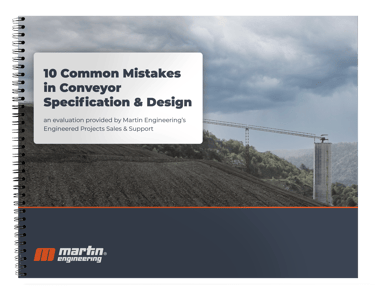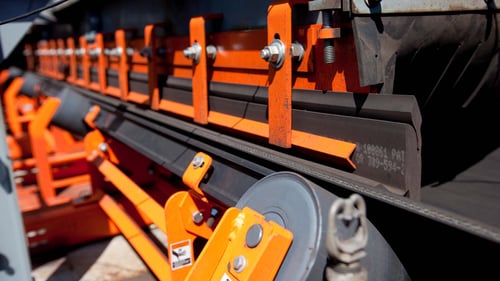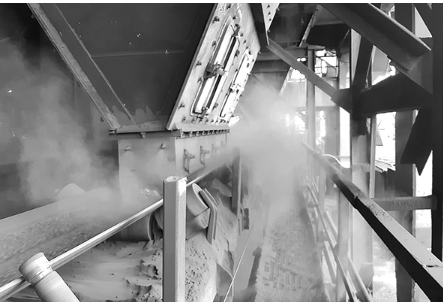By Jerad Heitzler on Aug 11, 2023 10:32:16 AM
In case you haven’t heard, MSHA’s proposed rule on silica dust control has taken a step forward. The new MSHA silica rule, proposed on July 13th, reflects what OSHA has already done. The new PEL (Permissible Exposure Limit) should not surprise or shock anyone. The only surprise should be how long it took MSHA to propose it, considering OSHA acted in 2016. It's expected to become a regulation, but how soon is yet to be determined.
As I read the proposed rule, I quickly noticed MSHA’s focus on engineering controls. They state, several times, that mines will need to comply with the new regulation using engineering controls. Specifically, they state “engineering controls, which are most effective, are designed to remove or reduce the hazard at the source." I have instructed  on controlling dust around conveyors for almost 15 years. In every single class, someone in the group mentions engineering controls. They are an effective way to reduce the risk of injury or serious illness and in many’s opinion (including MSHA's), the best way.
on controlling dust around conveyors for almost 15 years. In every single class, someone in the group mentions engineering controls. They are an effective way to reduce the risk of injury or serious illness and in many’s opinion (including MSHA's), the best way.
Mines have many sources of dust, but one of the most significant creation points is a belt conveyor transfer point or load zone. Load zones create dust because as bulk material is transferred from one belt to another or from a crusher to a belt, the material is in a state of free fall and exposed to significant airflow. This airflow, when velocity is fast enough, carries silica dust until the  . We’ve been teaching this for many years, over 75 to be exact. More importantly, we’ve been preaching how to reduce the velocity using guess what, engineering controls.
. We’ve been teaching this for many years, over 75 to be exact. More importantly, we’ve been preaching how to reduce the velocity using guess what, engineering controls.
In their proposed rule, MSHA mentions  as effective engineering controls to meet the new PEL. This is where you should take exception, especially on conveyor load zones. Collection and suppression can be helpful in many cases, but we have discovered them to be costly, minimally effective, and requiring excessive maintenance.
as effective engineering controls to meet the new PEL. This is where you should take exception, especially on conveyor load zones. Collection and suppression can be helpful in many cases, but we have discovered them to be costly, minimally effective, and requiring excessive maintenance.
 An effective engineering control for silica dust at problematic conveyor load zones is to eliminate the dust at its source…that source being air velocity. When mines can reduce the air speed inside a
An effective engineering control for silica dust at problematic conveyor load zones is to eliminate the dust at its source…that source being air velocity. When mines can reduce the air speed inside a  , that transfer point greatly reduces the silica dust that workers are exposed to. Slowing airflow is achieved by sealing a transfer point with the correct sealing system and supporting the belt better than most mines do. Adequate belt support eliminates sag between idlers, creating a stable belt that skirting can properly seal against. Then, dust curtains are used to slow the air or force it into a dust bag, eventually slowing the airspeed at the end of what we call the settling zone to a speed that can no longer carry silica dust.
, that transfer point greatly reduces the silica dust that workers are exposed to. Slowing airflow is achieved by sealing a transfer point with the correct sealing system and supporting the belt better than most mines do. Adequate belt support eliminates sag between idlers, creating a stable belt that skirting can properly seal against. Then, dust curtains are used to slow the air or force it into a dust bag, eventually slowing the airspeed at the end of what we call the settling zone to a speed that can no longer carry silica dust.
We refer to this concept as containment, which has helped mines and process plants around the world control dust for many years. It's an effective, inexpensive way for mines to control silica dust.
I strongly believe the new proposed rule from MSHA will become a regulation. If you disagree with that, you might be proven wrong in time. You should expect MSHA to enforce this strongly once it passes. The new silica rule has gained traction in the past year and a half and inspectors are ready to leverage a final rule. Compliance won’t be difficult for conveyors that are a significant source of dust - as many typically are. Engineering controls sound expensive and complex but 0n conveyor load zones and transfer points, they are not. They are easy to maintain and effective at controlling silica dust.

.jpg)
.jpg?width=500&height=375&name=Dust%20transfer%20point_300dpi(3500x3000).jpg)




comments